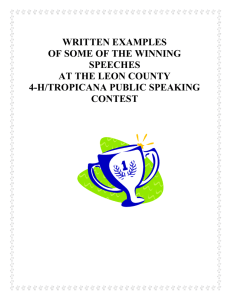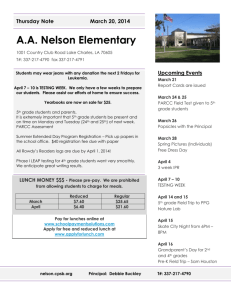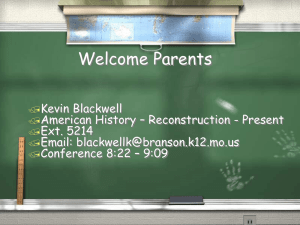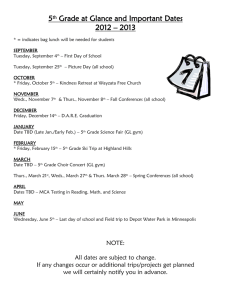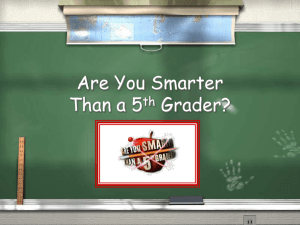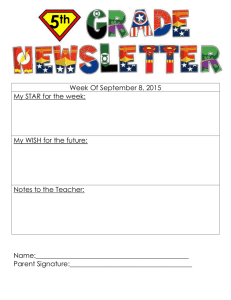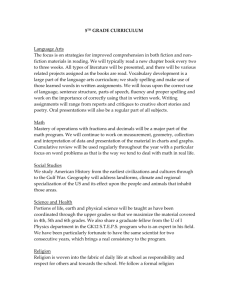Reading and Listening for Comprehension
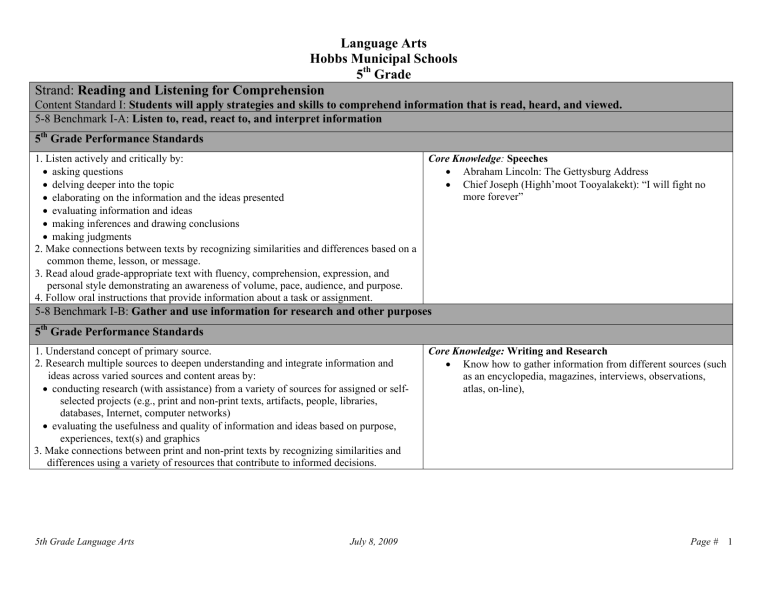
Language Arts
Hobbs Municipal Schools
5
th
Grade
Strand: Reading and Listening for Comprehension
Content Standard I: Students will apply strategies and skills to comprehend information that is read, heard, and viewed.
5-8 Benchmark I-A: Listen to, read, react to, and interpret information
5 th
Grade Performance Standards
1. Listen actively and critically by:
• asking questions
• delving deeper into the topic
• elaborating on the information and the ideas presented
• evaluating information and ideas
• making inferences and drawing conclusions
• making judgments
2. Make connections between texts by recognizing similarities and differences based on a common theme, lesson, or message.
3. Read aloud grade-appropriate text with fluency, comprehension, expression, and personal style demonstrating an awareness of volume, pace, audience, and purpose.
4. Follow oral instructions that provide information about a task or assignment.
5-8 Benchmark I-B: Gather and use information for research and other purposes
Core Knowledge: Speeches
•
Abraham Lincoln: The Gettysburg Address
•
Chief Joseph (Highh’moot Tooyalakekt): “I will fight no more forever”
5 th
Grade Performance Standards
1. Understand concept of primary source.
2. Research multiple sources to deepen understanding and integrate information and
• ideas across varied sources and content areas by: conducting research (with assistance) from a variety of sources for assigned or selfselected projects (e.g., print and non-print texts, artifacts, people, libraries, databases, Internet, computer networks)
• evaluating the usefulness and quality of information and ideas based on purpose, experiences, text(s) and graphics
3. Make connections between print and non-print texts by recognizing similarities and differences using a variety of resources that contribute to informed decisions.
Core Knowledge: Writing and Research
•
Know how to gather information from different sources (such as an encyclopedia, magazines, interviews, observations, atlas, on-line),
5th Grade Language Arts July 8, 2009 Page # 1
5-8 Benchmark I-C: Apply critical thinking skills to analyze information
5 th
Grade Performance Standards
1. Evaluate text to determine author’s purpose and opinion by:
• evaluating inferences, conclusions, and generalizations
• identifying elements of fiction and non-fiction that support plot development, choice of words, effectiveness of figurative language and personification
2. Evaluate the usefulness and quality of information and ideas based on purpose, experiences, text.
3. Respond to fiction, non-fiction, poetry, and drama using interpretive, critical, and evaluative processes by:
• analyzing word choice and content
• examining reasons for a character’s actions
• creating and presenting a product that demonstrates a personal response
• examining alternative perspectives
4. Make informed judgments about bias, propaganda, stereotyping, and media techniques.
5. Analyze cause and effect relationships, compare and contrast information, facts, characters, and objects to predict a logical outcome based on the information in the selection.
6. Distinguish between fact and opinion.
Core Knowledge: Poetry
•
The Arrow and the Song (Henry Wadsworth Longfellow)
•
Barbara Frietchie (John Greenleaf Whittier)
•
Battle Hymn of the Republic (Julia Ward Howe)
•
A bird came down the walk (Emily Dickinson)
•
Casey at the Bat (Ernest Lawrence Thayer)
•
The Eagle (Alfred Lord Tennyson)
•
I Hear America Singing (Walt Whitman)
•
I like to see it lap the miles (Emily Dickinson)
•
I, too, sing America (Langston Hughes)
•
Incident (Countee Cullen)
•
Jabberwocky (Lewis Carroll)
•
Narcissa (Gwendolyn Brooks)
•
O Captain! My Captain! (Walt Whitman)
•
A Poison Tree (William Blake)
•
The Road Not Taken (Robert Frost)
•
The Snowstorm (Ralph Waldo Emerson)
•
Some Opposites (Richard Wilbur)
•
The Tiger (William Blake)
•
A Wise Old Owl (Edward Hersey Richards)
Core Knowledge: Fiction and Drama
•
The Adventures of Tom Sawyer (Mark Twain)
•
Don Quixote (Miguel de Cervantes)
•
Little Women (Part First) (Louisa May Alcott)
•
Narrative of the Life of Frederick Douglass (Frederick Douglass)
•
The Secret Garden (Frances Hodgson Burnett)
•
Tales of Sherlock Holmes, including “The Red-Headed League”
(Arthur Conan Doyle)
•
A Midsummer Night’s Dream (William Shakespeare)
Core Knowledge: Myths and Legends
•
A Tale of the Oki Islands
•
Morning Star and Scarface: the Sun Dance
American Indian Trickster stories
5th Grade Language Arts July 8, 2009 Page # 2
5-8 Benchmark I-D: Demonstrate competence in the skills and strategies of the reading process
5 th
Grade Performance Standard
1. Apply enabling strategies and skills to read by:
• expanding and refining vocabulary through wide reading, word study, content area study, writing process elements, writing as a tool, debate, discussions, seminars, and examining the author’s craft
• using word reference materials
• selecting key vocabulary critical to the text and applying appropriate meanings for understanding
• reading independently to increase fluency and build background knowledge
2. Interact with the text by:
• making predictions
• formulating questions
• supporting answers from textual information, previous experience, and/or other
•
• sources drawing on personal, literary, and cultural understandings seeking additional information
3. Read a variety of texts (e.g., fiction, nonfiction, newspaper and magazine articles, poetry, drama)
4. Choose materials to read independently, identifying the main ideas and significant details, and determine the correct sequence of events or information.
Core Knowledge: Terms
• onomatopoeia
• alliteration
• pen name (pseudonym)
• literal and figurative language imagery
metaphor and simile symbol
personification
• tragedy and comedy
• act, scene
•
Globe Theater
Core Knowledge: Vocabulary
•
Know how the following prefixes and suffixes affect meaning o Prefixes: anti (as in antisocial, antibacterial ) co (as in coeducation, co-captain) fore (as in forefather, foresee) il, ir (as in illegal, irregular) inter (as in interstate) mid (as in midnight) post (as in postseason) semi (as in semicircle) o Suffixes:
ist (as in artist)
ish (as in stylish)
ness (as in forgiveness, happiness)
tion, sion (as in relation, extension)
5th Grade Language Arts July 8, 2009 Page # 3
Strand: Writing and Speaking for Expression
Content Standard II: Students will communicate effectively through speaking and writing.
5-8 Benchmark II-A: Use speaking as an interpersonal communication tool
5 th
Grade Performance Standards
1. Read aloud grade-level text with fluency, comprehension, expression, and personal style demonstrating an awareness of volume, pace, audience, and purpose.
2. Use language to:
• formulate hypotheses
• evaluate information and ideas
• present and support arguments
• influence the thinking of others
3. Make presentations to inform or persuade, selecting vocabulary for impact.
Core Knowledge:
•
Poetry, stories, drama, myths and legends
5-8 Benchmarks II-B: Apply grammatical and language conventions to communicate
5 th
Grade Performance Standards
1. Write sentences that use:
• independent and dependent clauses
• transitions
• conjunctions to connect ideas
2. Identify and correctly use verbs that are often misused (e.g., lie/lay, sit/set, rise/raise).
3. Use colons and quotation marks correctly.
4. Spell most commonly used words accurately using a multi-strategy approach to learn new spellings.
5. Edit final product for grammar, language conventions, and format.
6. Create and deliver focused, coherent presentations that convey ideas clearly and relate to the background and interest of the audience using a variety of media.
7. Evaluate the content of oral communication.
Core Knowledge: Grammar and Usage
•
Understand what a complete sentence is, and identify subject and predicate, correct fragments and run-ons.
•
Identify subject and verb in a sentence and understand they must agree.
•
Know the following parts of speech and how they are used: nouns, verbs (action verbs and auxiliary verbs), adjectives
(including articles), adverbs, conjunctions, and interjections.
•
Understand pronouns must agree with their antecedents in case
(nominative, objective, possessive), number, and gender.
•
Correctly use punctuation: a colon before a list, commas with appositive, punctuation studied in earlier grades.
•
Use underlining or italics for titles of books.
5th Grade Language Arts July 8, 2009 Page # 4
5-8 Benchmarks II-C: Demonstrate competence in the skills and strategies of the writing process
5 th
Grade Performance Standards
1. Produce a variety of written products that demonstrate competence in:
• persuasive writing (e.g., states a clear position, elaborates on the position with reasons, examples, information and other evidence)
• autobiographical writing
• essays that speculate on cause and effect
2. Apply the writing process through:
• pre-writing
• creating a rough draft
• revising for clarity of thought and focused communication
• editing
• publishing and sharing of final product
3. Create journals, notes, stories, reports, and letters using appropriate formats and multimedia technologies to communicate to an audience for a specific purpose.
4. Focus revision on creating simple and/or complex sentences for clarity and impact and on developing a lead, characters, or mood.
Core Knowledge: Writing and Research
•
Produce a variety of types of writing – including reports, summaries, letters, descriptions, research essays, essays that explain a process, stories, poems – with a coherent structure or story line.
•
Know how to gather information from different sources
(such as an encyclopedia, magazines, interviews, observations, atlas, on-line), and write short reports synthesizing information from at least three different sources, presenting the information in his or her own words, with attention to the following: understanding the purpose and audience of the writing, defining a main idea and sticking to it, providing an introduction and conclusion, organizing material in coherent paragraphs, illustrating points with relevant examples, and documenting sources in a rudimentary bibliography
5th Grade Language Arts July 8, 2009 Page # 5
Strand: Literature and Media
Content Standard III: Students will use literature and media to develop an understanding of people, societies, and the self.
5-8 Benchmarks III-A: Use language, literature, and media to understand various social and cultural perspectives
5 th
Grade Performance Standards
1. Explain why similar character types are found in multiple cultures.
2. Identify social/cultural values and beliefs reflected in literature and media.
3. Identify archetypal patterns and symbols depicted through literature and media of various cultures.
5-8 Benchmarks III-B: Identify ideas and make connections among literary works
Core Knowledge: Sayings and Phrases
•
Birthday Suit
•
Bite the hand that feeds you.
•
Chip on your shoulder
•
Count your blessings.
•
Eat Crow
•
Eleventh hour
•
Eureka!
•
Every cloud has a silver lining.
•
Few and far between
•
Forty winks
•
Few and far between
•
The grass is always greener on the other side of the hill.
•
To kill two birds with one stone
•
Lock, stock and barrel
•
Make a mountain out of a molehill
•
A miss is as good as a mile.
•
It’s never too late to mend.
•
Out of the frying pan and into the fire
•
A penny saved is a penny earned .
•
Read between the lines.
•
Sit on the fence
•
Steal his/her thunder
•
Take the bull by the horns.
•
Till the cows come home
•
Time heals all wounds.
•
Tom, Dick, and Harry
•
Vice Versa
•
A watched pot never boils.
•
Well begun is half done.
•
What will be will be.
5 th
Grade Performance Standards
1. Identify main conflict in a plot and describe how it is resolved.
2. Contrast the actions and motives of characters in literary works.
3. Explain the importance of a character’s actions to the plot and theme of a literary work.
Core Knowledge:
Read Core Knowledge stories, myths and legends, drama, and speeches.
5th Grade Language Arts July 8, 2009 Page # 6

